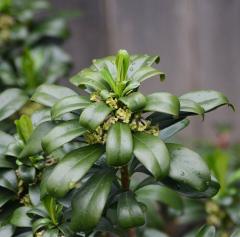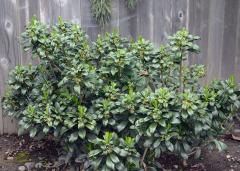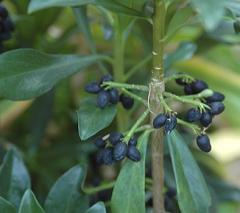by Vancouver Island Master Gardeners Association
Question: How to identify Invasive Daphne and eradicate?
Answer: To identify Daphne laureola and remove it safely from my garden.
Botanical name: Daphne laureola
Common names: Spurge-laurel, Daphne-laurel or Laurel-leaved Daphne
Daphne laureola is an evergreen, broadleaf shrub. There is also a semi-prostrate compact form; Daphne laureola subsp. Philippi. D. laureola is somewhat similar in appearance to our Pacific Rhododendron’s. This plant is particularly damaging as it has escaped from gardens and naturalized in woodlands and other areas it finds to its liking.
D.laureola has multiple branches and grows in an upright or decumbent fashion to about 1.5 meters in height. Its leaves are alternate, simple and whorl at its branch tips. When young, the branches are a light green and become more greyish as the plant matures. As the plant matures, it only has leaves at its branch tips. Its leaves are tapered at the base, are a deep glossy green and abovate to oblong in shape and about 7 cm x 2 cm on average in size.
D.laureola’s flowers are small, insignificant and form a raceme at the branch tips. The flowers can have an unpleasant odor coming from the cambium, however, sometimes it can have no scent at all.
Outside its native habitat, this plant has become a dangerous invasive weed. It grows in sun or shade and thrives in the understory of our Pacific Northwest forests.
D. laureola colonizes an area by both seeding and root suckering forming monotypic stands which out complete native vegetation. Its purplish black seeds are easily spread by birds which don’t appear to be bothered by its chemicals.
There is now some evidence by plant scientists, that this plant alters the soil chemistry and acidity preventing the establishment of native species.
Daphne is listed as a poisonous plant by the Canadian Poisonous Plants Information System, and as a toxic plant by Worksafe B.C. Its toxic sap can cause skin rashes, nausea, swelling of the tongue and in rare cases coma and death when ingested. It is mainly children and pets that are affected.
The plants contains irritant chemicals that cause pain, burning and tingling sensations on exposed skin. These are intensified on mucous membranes in the mouth, throat and stomach after ingesting the fruits.
Remedial action:
To remove Daphne, always wear gloves and pull small plants by hand. This is much easier when the ground is moist.
When endeavoring to remove a large stand when fruits are present, begin by cutting off the heads of all the plants so fruits cannot be dispersed. Remove larger plants that are greater than 30 cm by cutting them off below the ground. Cutting their stems above ground only encourages multiple stems to form. Leave their roots in the ground and disturb as little soil as possible. Seal the plants in dark plastic bags and DO NOT compost or burn Daphne laureola. The plants should be dried in the sun inside their garbage bags or inside a tarp and then properly disposed of in a municipal landfill. Help to eradicate this thug by removing plants before they set seed.
Photo Credits: Daphne laureola | Landscape Plants | Oregon State University




